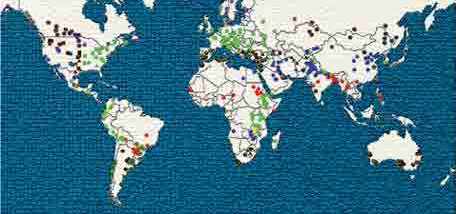Wheat genetic resources
Contact person for Wheat: Thomas Payne, CIMMYT, Mexico
Contributors to this page: CIMMYT - Wheat, Mexico (Thomas Payne) and ICARDA, Syria (Ahmed Amri) with inputs also received from CIMMYT - Maize, Mexico (Suketoshi Taba); USDA - National Small Grains Collection, Aberdeen, Idaho, USA (Harold Bockelmann); CGN, Wageningen, The Netherlands (website) and IPK, Gatersleben, Germany (Helmut Knűpffer).
External reviewer: Jan Valkoun (Czech Republic).
Compilation of best practices
Information on current practices for genebank management of wheat was gathered from current genebank practices and accumulated experience from CIMMYT and ICARDA, reviewed from literature and existent websites (e.g. wheat knowledge bank) of major genebanks (CIMMYT, USDA-National Small Grains Collection (Aberdeen, Idaho), CGN-Wageningen, and IPK-Gatersleben). This provided the basic information for selection, justification and recommendations that were then compiled into a data collection form that was edited and uploaded into this website, complemented with relevant photos and revised and validated by the crop experts.

Wheat growing areas in the world (photo: CIMMYT) |
|
|
Wheat (photo: CIMMYT) |
Importance and origin
Wheat is the world’s most widely grown crop with a global production of over 600 million tons produced from about 210 million hectares in many different countries in Europe, Asia, North Africa and the Americas. The area sown to wheat has doubled over the last 50 years and production per hectare has almost tripled. This increase in production is due in part to the efforts of national, regional and international breeding programmes in producing improved cultivars. Wheat is also the world’s most widely traded food grain with about 105 million tons or about 18% of world production traded each year.
Types
By the 1920s it was recognized that cultivated wheat species of the genus Triticum belonged to three ploidy groups with chromosome numbers of 2n = 2x = 14 (T. monococcum), 28 (T. turgidum and T. timopheevii), and 42 (T. aestivum and T. zhukovskyi) (Gill and Friebe, 2002).
Utilization
World wheat production is almost entirely based on only two species, T. aestivum, common or bread wheat which accounts for about 95% of world production and T. turgidum ssp. durum, macaroni or durum wheat, which accounts for the other 5% of production. The remaining cultivated species are largely historical relics.
References and further reading
CGN Quality Manual [online]. Available from: http://documents.plant.wur.nl/cgn/quality/content/QM11.htm. Date accessed: 4 February 2010.
Ellis RH. 1998. Longevity of seeds stored hermetically at low moisture contents. Seed Science Research 8 supplement 1:9-10.
Ellis RH, Hong TD, Roberts EH. 1985. Handbook of seed technology for genebanks volume I. Principles and methodology. Handbooks for Genebanks no. 2. International Board for Plant Genetic Resources, Rome. http://www.bioversityinternational.org/index.php?id=19&user_bioversitypublications_pi1[showUid]=2405.
FAO/IPGRI. 1994. Genebank standards. Food and Agriculture Organization of the United Nations, Rome and International Plant Genetic Resources Institute, Rome. Available in English, Spanish, French and Arabic.
Gill BS, Friebe B. 2002. Cytogenetics, phylogeny and evolution of cultivated wheats. In: Curtis BC, Rajaram S, Gómez Macpherson H, editors. Bread Wheat: improvement and production. Food and Agriculture Organization of the United Nations, Rome, Italy. pp. 71-88. Available from: http://www.k-state.edu/wgrc/Publications/2002/8697.pdf.
Gomez-Campo C. 2006. Erosion of genetic resources within seed genebanks: the role of seed containers. Seed Science Research 16:291-294.
Hanson J. 1985. Procedures for handling seeds in genebanks. Practical manuals for genebanks no. 1. International Board for Plant Genetic Resources, Rome. HTML version available from: http://www2.bioversityinternational.org/publications/Web_version/188/.
Hong TD, Ellis RH. 1996. A protocol to determine seed storage behavior. IPGRI Technical Bulletin No. 1. International Plant Genetic Resources Institute. Rome. Italy. Available here.
International Seed Testing Association ISTA. 1993. International rules for seed testing. Seed Science and Technology 21, Supplement.
Justice OL, Bass LN. 1978. Principles and practices of seed storage. Agriculture handbook no. 506. U.S. Government Printing Office, Washington D.C.
Mezzalama M, Gilchrist L, McNab A. 2005. Seed Health: Rules and regulations for the safe movement of germplasm. Mexico. D.F., CIMMYT.
Pardey PG, Koo B, Van Dusen ME, Skovmand B, Taba S, Wright BD. 2001. Costing the conservation of genetic resources: CIMMYT’s ex situ maize and wheat collection. Crop Science 41(4):1286-1299.
Probert RJ, Hay FR. 2000. Keeping seeds alive. In: Black M, Bewley JD, editors. Seed technology and its biological basis. CRC Press LLC. USA and Canada. pp. 375-404.
Taba S, van Ginkel M, Hoisington D, Poland D. 2004. Wellhausen-Anderson Plant Genetic Resources Center: Operations Manual, 2004. El Batan, Mexico: CIMMYT. Available here (0.5 MB)
Thormann I, Metz T, Engels JMM. 2004. The Species Compendium (release 1.0; December 2004). [online]. Available from: http://www.bioversityinternational.org/scientific_information/Information_Sources/Species_Databases/Species_Compendium.html. Date accessed: 4 February 2010.
Walters C, Wheeler LM, Grotenhuis JM. 2005. Longevity of seeds stored in a genebank: species characteristics. Seed Science Research 15:1-20.
Warham EJ, Butler LD, Sutton BC. 1996. Seed testing of maize and wheat: A laboratory guide. CIMMYT, Mexico and CAB International, UK.
Documentary:
Watch a documentary on the importance of genetic diversity, landraces and crop wild relatives, to the future of agriculture in the face of climate change and other challenges.
Comments
- No comments found



 Wheat
Wheat

Leave your comments
Post comment as a guest